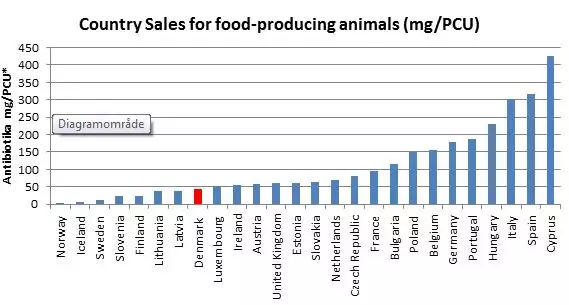The use of antimicrobials in the Danish pig sector is very low. Among those European countries with a high number of food-producing animals (France, Spain, Belgium, Germany, Netherlands and Denmark) the latest ESVAC report shows, that Denmark is the country with the lowest consumption of antimicrobials per food producing animal.

All sales of Veterinary Medicine Products (VMP’s) are registered in the Danish database VetStat with relevant information, e.g. product name, active substance, quantity, animal species, animal group and farm number. The registrations are done primarily by the pharmacy. The database was established in 2000. VetStat belongs to the Danish Veterinary and Food Administration. The Danish Veterinary and Food Administration uses the information in VetStat to monitor the use of VMP's – especially antimicrobials – at farm level.
VetStat offers a very high transparency on the use of VMP's and enables the Danish Veterinary and Food Administration to make targeted policies. During the period 2009 – 2015, the use of antimicrobials in the Danish pig sector has been reduced by 22 percent. This is primarily due to the Yellow Card initiative implemented in 2010. The initiative aims to lower the use of antimicrobials further in the pig sector. The system has been very effective in restricting and reducing the use of antimicrobials for pigs.
Despite the low use of antimicrobials in Denmark, the Danish government has implemented further measures in order to reduce the livestock-associated MRSA problem. The main target is to ensure that the livestock-associated MRSA bacteria are kept at the farm and to reduce the level of LA MRSA in the animals. Mandatory increase of hygiene measures such as change of clothes and hand wash before leaving the pig stable has been implemented. In addition to that, introduction of further requirements in order to reduce the use of antimicrobials will be initiated.
Denmark has a comprehensive control and surveillance activity on the use of Veterinary Medicine Products (VMP) in food producing animals, especially on the use of antimicrobials. Activities are carried out at farm (inspections) and at central level (administrative control of registrations in the database VetStat). Furthermore, Denmark has a very strict sanction policy in cases of fraudulence with illegally acquired VMPs.
A range of EU and national rules secures, that antimicrobials are available and that they are used in a responsible manner:
-
All VMPs are prescription only and can only be distributed from pharmacies and companies specially approved by the Danish Medicines Agency.
-
The veterinarian is the “gate keeper” as only veterinarians can prescribe VMP’s for treatment of food producing animals.
-
Private veterinary practitioners are not allowed to profit from the sale of VMP’s and may only add a small fixed service charge to the cost price.
-
To ensure a high quality in the handling of health problems at farm level, farmers and the veterinary practitioners enter a one-to-one relationship in a so called “Veterinary Advisory Service Contract”. This ensures frequent visits and high quality advisory service on animal health and welfare.
Very few cases of fraudulent use of illegally acquired antimicrobials are seen in Denmark. During the last ten years the Danish Veterinary and Food Administration has only seen one case of fraudulent use of illegally acquired antimicrobials in pig production. The case is pending in the legal system.
To sum up, the very low level of antimicrobial use in the Danish pig sector is due to:
-
a very high general animal health level,
-
Veterinary Advisory Service Contracts,
-
the veterinarian acts as the “gate keeper” when VMPs are prescribed,
-
very high hygiene demands in the pig production,
-
the Yellow Card System – restricting the use of antimicrobials,
-
credible and substantial records on use of antimicrobials in the database VetStat, and
-
a reliable and efficient control system and very few cases of fraudulence.